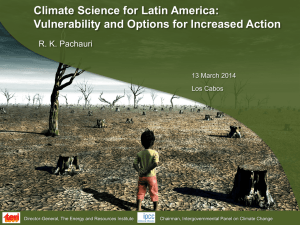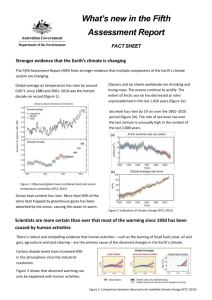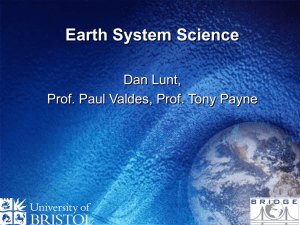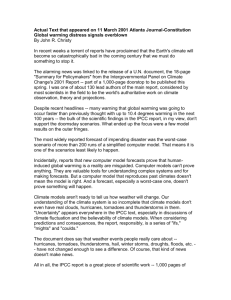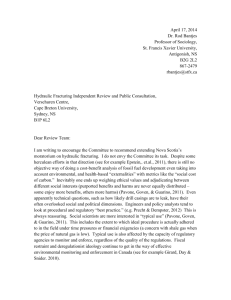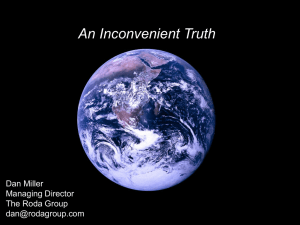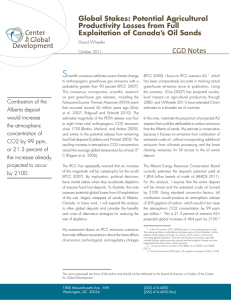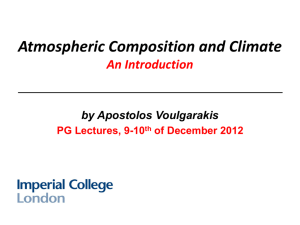The Future of Climate Change
advertisement
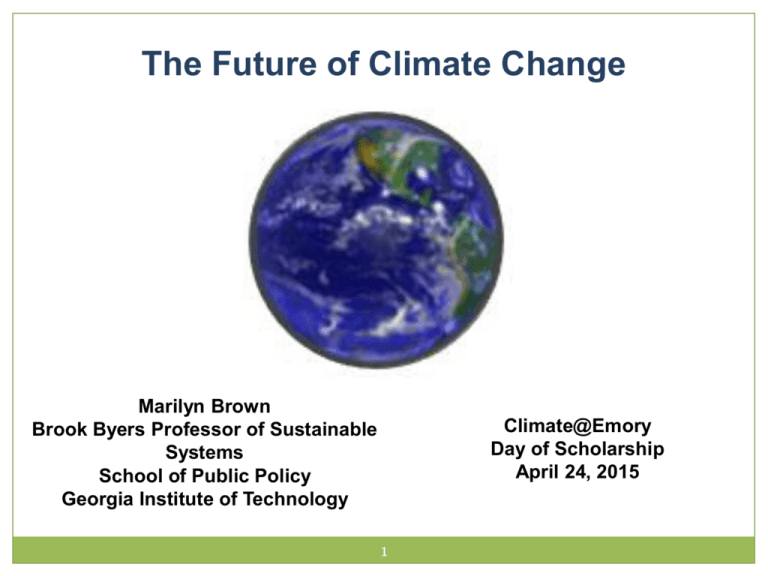
The Future of Climate Change Marilyn Brown Brook Byers Professor of Sustainable Systems School of Public Policy Georgia Institute of Technology Climate@Emory Day of Scholarship April 24, 2015 1 The Intergovernmental Panel on Climate Change (IPCC) 2 Provides policymakers with regular assessments of the scientific basis of climate change, its impacts and future risks, and options for adaptation and mitigation Informs negotiations of the UN Framework Convention on Climate Change (UNFCCC) Website for IPCC reports: http://www.ipcc.ch/report/ar5/ • Established by World Meteorological Organization (WMO) and UN Environment Program (UNEP) in 1988 • Mandate from December ‘88 UN General Assembly resolution • “The IPCC is a scientific body under the auspices of the United Nations (UN).” (http://www.ipcc.ch/organization/organiz ation.shtml#.Uucv-NIo4-U) • “The IPCC … is open to all member countries of the United Nations (UN) and WMO.” (http://www.ipcc.ch/organization/organiz ation.shtml#.Uucv-NIo4-U) 3 1990 1991 1992 1993 1994 1995 1996 1997 1998 1999 2000 2001 2002 2003 2004 2005 2006 2007 2008 2009 2010 2011 2012 2013 2014 First Assessment Report (FAR) Second Assessment Report (SAR) Third Assessment Report (TAR) Fourth Assessment Report (AR4) Nobel Peace Prize (shared with Al Gore) Fifth Assessment Report (AR5) 831 authors and editors 1990 1991 1992 1993 1994 1995 1996 1997 1998 1999 2000 2001 2002 2003 2004 2005 2006 2007 2008 2009 2010 2011 2012 2013 2014 4 First Assessment Report (FAR) Second Assessment Report (SAR) Third Assessment Report (TAR) Fourth Assessment Report (AR4) Nobel Peace Prize (shared with Al Gore) Fifth Assessment Report (AR5) 831 authors and editors 1990 1991 1992 1993 1994 1995 1996 1997 1998 1999 2000 2001 2002 2003 2004 2005 2006 2007 2008 2009 2010 2011 2012 2013 2014 First Assessment Report (FAR) Second Assessment Report (SAR) Third Assessment Report (TAR) “The unequivocal detection of the enhanced greenhouse effect from observations is not likely for a decade or more.” “The balance of evidence suggests a discernable human influence on global climate.” “There is new and stronger evidence that most of the warming observed over the last 50 years is attributable to human activities.” “Most of the observed increase is global average temperature since the mid-20th century is very likely due to the observed increase in anthropogenic greenhouse gas Fourth Assessment Report (AR4) Nobel Peace Prize (shared with Al Gore) concentrations.” Fifth Assessment Report (AR5) 831 authors and editors “It is extremely likely that more than half of the observed increase in global average surface temperature from 1951 to 2010 was caused by the anthropogenic increase in greenhouse gas concentrations and other anthropogenic forcings together.” 5 Observed Trends 6 Globally averaged land & ocean temperature anomaly Warming is unequivocal +0.85°C since 1880 1983-2012 likely the warmest period since 1400 Globally averaged sea level change Ocean heat content is increasing Sea-level rose by 0.19 m Source: IPCC Fifth Assessment Report Anthropogenic Forcings are Needed to Match Climate Models to Observations 7 Source: IPCC Figure 1.10 Dissecting global warming 8 Source: IPCC Figure SPM.3 Natural Catastrophes are Increasing in Frequency, Magnitude & Cost 9 Global Natural Catastrophes 1980-2013 Source: Munich RE, 2014, 2013 Natural Catastrophe Year in Review. Increased Flooding is Forecast Of the 50 states, Florida is the most vulnerable to rising sea levels, standing just a few feet above the current level. Miami is in an especially dangerous position because of its porous limestone foundation. Source: http://www.nytimes.com/interactive/2014/03/27/world/climate-risingseas.html?_r=1 Global Surface Temperature Projections 11 Global surface temperature change for the end of the 21st century is likely to exceed 1.5°C relative to 1850 to 1900 for all RCP scenarios except RCP2.6. Warming will continue beyond 2100 under all RCP scenarios except RCP2.6. Source: IPCC. RCP = Representative Concentration Pathway (+ total radiative forcing in 2100 relative to 1750) Projected Sea Level Rise 12 Global sea level is expected to rise at an increasing rate. Over the last two decades, the Greenland and Antarctic ice sheets have been losing mass, glaciers have continued to shrink almost worldwide, and Arctic sea ice has continued to melt. The Door is Closing on 450 ppm CO2 (or a 2°C Rise in Global Temperatures) 13 Four-fifths of the total energy-related CO2 emissions of the 450 Scenario are already “locked-in” by existing capital stock World Energy-Related CO2 Emissions by Scenario Source: International Energy Agency. 2011. World Energy Outlook. IPCC Informs International and Domestic Climate Policy 14 S o 15,000,000,00 0 United States 6,797,200,000 Southeast 1,934,720,000 Georgia 230M Source: Daniel Rochberg. 2015. Emory University Global 43,185,900,000 metric tons New U.S. Policies are Emerging: Clean Power Plan (CPP) 16 The CPP seeks to slash carbon emissions from existing U.S. power plants by 30% from 2005 levels by 2030. In the CPP, EPA proposed state-specific limits on CO2 emissions from existing fossil fuel plants How the Goals were Calculated See more analysis of the Clean Power Plan, by Georgia Tech: http://cepl.gatech.edu/drupal/node/75 The Cost of CPP Compliance Appears to be Higher in the South 17 CO2 Rate-Based Goals and Carbon Intensity of Fuels (Lbs-CO2/MWh): South US (954) (998) VA(810) GA (834) LA (883) Low CO2 Rates 500 WV (1,620) AL (1,059) KY (1,763) MO (1,771) State Rate-Based Goals TN (1,163) 1,000 1,500 2,000 Bituminous Coal (2,080) SC (772) TX (791) AR (910) NC (992) Residual Oil (1,680) FL (740) OK (895) Natural Gas (1,220) MS (692) Source of carbon intensity for specific fuels is http://www.eia.gov/tools/faqs/faq.cfm?id=74&t=11 High CO2 Rates The White House Climate Pledge to the UNFCCC (March 31, 2015) 18 The U.S. will seek to cut its GHG emissions by 26% to 28% from 2005 levels by 2025, in a target submitted to the UNFCCC. The U.S. Intended Nationally Determined Contribution (INDC) is consistent with the November agreement between President Obama and Chinese President Xi Jinping. The U.S. target compares to the Obama administration’s 2009 commitment to reduce emissions by 17% below 2005 levels by 2020. The U.S. Target 19 The CPP seeks to slash carbon emissions from existing U.S. power plants by 30% from 2005 levels by 2030. On 4/7/15, a White House fact sheet on the INDC noted that the Clean Power Plan seeks to deliver $55 billion to $93 billion in annual net benefits by reducing carbon pollution and other harmful pollutants. Pledges To Date: More is Needed to Meet the 15 Billion Ton Goal 20 By the informal deadline set by the United Nations in 2013, 33 countries had submitted plans to fight climate change beyond 2020. S Desire for Improved Well-Being Adaptation & Mitigation: Complementary Strategies Conservation Demand for Goods and Services Efficiency Demand for Energy Low-Carbon Energy Avoiding the Unmanageable CO2 Emissions Mitigation Carbon Cycle Engineering CO2 in Atmosphere Solar Radiation Management Global Climate IPCC/SPM: “no single option is sufficient by itself.” Anticipatory Adaptation Reduced Biophysical and Socioeconomic Risks Adaptation Reactive Adaptation Reduced Cost of Emergency Response Managing the Unavoidable Source: Brown, Marilyn A. 2011. Climate Change and Global Energy Security (MIT Press). For More Information 22 Dr. Marilyn A. Brown, Brook Byers Professor of Sustainable Systems Georgia Institute of Technology School of Public Policy Atlanta, GA 30332-0345 Marilyn.Brown@pubpolicy.gatech.edu Climate and Energy Policy Lab: http://www.cepl.gatech.edu



